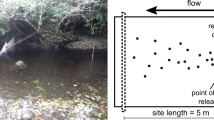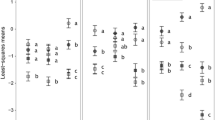Abstract
Aggressive interactions, foraging behaviour and microhabitat use were observed among four sympatric stream fishes inhabiting the water column: ayu (Plecoglossus altivelis), white-spotted charr (Salvelinus leucomaenis), masu salmon (Oncorhynchus masou) and Japanese dace (Tribolodon hakonensis), each species being categorised into five body-size classes (species-size groups; SSG's). Aggressive interactions were observed between most pairs of SSG's, an almost linear dominance order being apparent throughout the three-month study period. Ayu were relatively subordinate in June, but became the second most dominant in July and the most dominant in August, as a consequence of a reversal in dominance order with salmon. In contrast, smaller-sized dace, which continually suffered from intra- and interspecific aggression, occupied the most subordinate ranks throughout the study period. Intensive aggression was observed among various SSG's, exhibiting same microhabitat propensity throughout the three months. The direction and frequency of aggressive interactions varied month by month due to a reversal in dominance order between ayu and masu salmon, and/or changes in density, body size and resource use of the component members. Opponent selectivity was higher within SSG's, where resource use was assumed to be highly overlapping, rather than among SSG's throughout the study period. Correlation analysis indicated that opponent selectivity in aggressive interactions among SSG's was positively correlated with similarity in microhabitat selectivity in June, but not in other months or with that in foraging habits, suggesting that intensive aggressive behaviour reflected overlapping habitat use among assemblage members during a certain period.
Similar content being viewed by others
Literature Cited
Altmann, J. 1974. Observational study of behaviour: sampling methods. Behaviour, 49: 226–267.
Bain, M. B., J. T. Finn and H. E. Booke. 1985. Quantifying stream substrate for habitat analysis studies. North American Journal of Fisheries Management, 5: 499–506.
Chesson, J. 1983. The estimation and analysis of preference and its relationship to foraging models. Ecology, 64: 1297–1304.
Colwell, R. K. and D. J. Futuyma. 1971. On the measurement of niche breadth and overlap. Ecology, 52: 567–576.
Cunjuk, R. A. and J. M. Green. 1986. Influence of water temperature on behavioural interactions between juvenile brook charr,Salvelinus fontinalis and rainbow trout,Salmo gairdneri. Can. J. Zool., 64: 1288–1291.
De Staso, III, J. and F. J. Rahel. 1994. Influence of water temperature on interactions between juvenile Colorado River cutthroat trout and brook trout in a laboratory stream. Trans. Am. Fish. Soc., 123: 289–297.
Drickamer, L. C. and S. H. Vessey. 1992. Animal behaviour-mechanisms, ecology, and evolution. Wm. C. Brown Publishers, Indiana, 479 pp.
Ebersole, J. P. 1977. The adaptive significance of interspecific territoriality in the reef fishEupomacentrus leucostictus. Ecology, 58: 914–920.
Elliott, J. M. 1990. Mechanisms responsible for population regulation in young migratory trout, Salmo Trutta. III. The role of territorial behaviour. J. Anim. Ecol., 59: 803–818.
Fausch, K. D. 1984. Profitable stream positions for salmonids: relating specific growth rate to net energy gain. Can. J. Zool., 62: 441–451.
Fausch, K. D. and R. J. White. 1986. Competition among juvenile coho salmon, brook trout, and brown trout in a laboratory stream, and implications for Great Lake tributaries. Trans. Am. Fish. Soc., 115: 363–381.
Glova, G. J. 1986. Interaction for food and space between experimental populations of juvenile coho salmon (Oncorhynchus kisutch) and coastal cutthroat trout (Salmo clarki) in a laboratory stream. Hydrobiol., 131: 155–168.
Grant, J. W. A. 1990. Aggressiveness and the foraging behaviour of young-of-the year brook charr (Salvelinus fontinalis). Can. J. Fish. Aquat. Sci., 47: 915–920.
Hearn, W. E. 1987. Interspecific competition and habitat segregation among stream-dwelling trout and salmon: a review. Fisheries, 12(5): 24–31.
Hori, M. 1987. Mutualism and commensalism in a fish community in Lake Tanganyika. Pages 219–239in S. Kawano, J. H. Connell and T. Hidaka, eds., Evolutuion and coadaptation in biotic communities. University of Tokyo Press, Tokyo.
Huntingford, F. A., N. B. Metcalfe, J. E. Thorpe, W. D. Graham and C. E. Adams. 1990. Social dominance and body size in Atlantic salmon parr (Salmo salar L.). J. Fish Biol., 36: 877–881.
Iguchi, K. 1991. Visual stimuli causing the aggressive behaviour of ayuPlecoglossus altivelis. Bull. Nat. Res. Inst. of Fish. Sci., 2: 15–23. (In Japanese with Japanese and English summary.)
Katano, O. 1985. Aggressive behaviour and dominance relationships of the dark chub,Zacco temmincki with special reference to their individual recognition. Japan. J. Ichthyol., 32: 225–238.
Katano, O. 1990. Dynamic relationships between the dominance of male dark chub,Zacco temmincki, and their acquisition of females. Anim. Behav. 40: 1018–1034.
Katano, O. 1994. Aggressive interactions between the dark chub,Zacco temmincki, and the pale chub,Z. platypus, in relation to their feeding behaviour. Japan. J. Ichthyol., 40: 441–449.
Kawanabe, H. and N. Mizuno (eds.), 1989. Freshwater fishes of Japan, Yama-Kei Publishers, Tokyo. 719 pp. (In Japanese.)
Kohda, M. 1991. Intra- and interspecific social organization among three hebivorous cichlid fishes in Lake Tanganyika. Japan. J. Ichthyol., 38: 142–147.
Low, R. M. 1971. Interspecific territoriality in a pomacentrid reef fishPomacentrus flavicauda. Ecology, 52: 648–654.
Magnan, P. and G. J. Fitzgerald. 1984. Mechanisms responsible for niche shift of brook charr,Salvelinus fontinalis Mitchill, when living sympatrically with creek chub,Semotilus atromaculatus Mitchill. Can. J. Zool., 62: 1548–1555.
Mayama, H. 1992. Studies on the freshwater life and propagation technology of masu salmon,Oncorhynchus masou (Brevoort). Sci. Rep Hokkaido Salmon Hatchery, 46: 1–156. (In Japanese with English summary.)
Mittelbach, G. G. and C. W. Osenberg. 1993. Stage-structured interactions in bluegill: consequences of adult resource variation. Ecology, 74: 2381–2394.
Miyadi, D. 1960. A story of ayu. Iwanami-syoten, Tokyo. 226 pp. (In Japanese.)
Mizuno, N. and H. Kawanabe. 1957. Behaviour of salmon-like fish “ayu” in an area with closely established territories. Japan. J. Ecol., 7: 26–30.
Mizuno, N., H. Kawanabe, D. Miyadi, S. Mori, H. Kodama, R. Ohgushi, A. Kusakabe and Y. Furuya. 1958. Life history of some stream fishes with special reference to four cyrpinid species. Bulltin of Physiology and Ecology, College of Science, University of Kyoto, 81: 1–48. (In Japanese.)
Nakamura, M. 1969. Cyprinid fishes of Japan—studies on the life history of cyprinid fishes of Japan. Research Institute for Natural Resources Press, Tokyo. 455 pp. (In Japanese.)
Nakano, S. 1994. Variation in agonistic encounters in a dominance hierarchy of freely interacting red-spotted masu salmon (Oncorhynchus masou ishikawai). Ecol. Fresh. Fish., 3: 153–158.
Nakano, S. 1995a. Competitive interactions for foraging microhabitats in a size-structured interspecific dominance hierarchy of two sympatric stream salmonids in a natural habitat. Can. J. Zool., 73: 1845–1854.
Nakano, S. 1995b. Individual differences in resource use, growth and emigration under the influence of a dominance hierarchy in fluvial red-spotted masu salmon in a natural habitat. J. Anim. Ecol., 64: 75–84.
Nakano, S. and T. Furukawa-Tanaka. 1994. Intra- and interspecific dominance hierarchies and variation in foraging tactics of two species of stream-dwelling chars. Ecol. Res., 9: 9–20.
Newman, M. A. 1956. Social behaviour and interspecific competition in two trout species. Physiological Zoology, 29: 64–81.
Noakes, D. L. G. 1980. Social behaviour in young charrs. Pages 638–701in E. K. Balon, ed. Charrs, salmonid fishes of the genusSalvelinus. The Hague, Dr. W. Junk.
Orth, D. J. 1983. Aquatic habitat measurements. Pages 61–84in L. A. Neilsen and D. L. Johnson, eds. Fisheries Techniques., American Fisheries Society, Benthesda.
Power, M. E. and A. J. Stewart. 1987. Disturbance and recovery of an algae assemblage following flood in an Oklahoma stream. Am. Midl. Nat., 117: 333–345.
Ross, S. T. 1986. Resource partitioning in fish assemblages: a review of field studies. Copeia, 1986: 352–388.
Reeves, G. H., F. H. Everest and J. D. Hall 1987. Interactions between the redside shiner (Richardsonius balteatus) and the steelhead trout (Salmo gairdneri) in Western Oregon: the influence of water temperature. Can. J. Fish. Aquat. Sci. 44: 1603–1613.
SAS Institute. 1989. SAS/STAT user's guide, version 6, 4th ed., vol. 1. SAS Institute Inc., Cary. 943 pp.
Sokal, R. R. and F. J. Rohlf. 1981. Biometry. W. H. Freeman and Company, San Francisco. 859 pp.
Symons, P. E. K. 1976. Behavior, and growth of juvenile Atlantic salmon (Salmo salar) and three competitors at two stream velocities. J. Fish. Res. Board. Can., 33: 2766–2773.
Tanida, K., K. Yamashita and A. Rossiter. 1985. A portable current meter for field use. Japan. J. Limn., 46: 219–221.
Uchida, K., K. Iguchi and K. Kiso. 1995. Effects of water temperature on aggressive behaviour of the territorial ayuPlecoglossus altivelis in aquaria. Bull. Natl. Res. Inst. Fish. Sci., 7: 389–401.
Usio, N. and S. Nakano. In press. Temporal variation in foraging group structure of a size-structured stream fish assemblage. Env. Biol. Fish.
Werner, E. E. and J. F. Gilliam. 1984. The ontogenetic niche and species interactions in size-structured populations. Ann. Rev. Ecol. Syst., 15: 393–425.
Williams, A. H. 1979. Interference behavior and ecology of threespot damselfish (Eupomacentrus planifrons). Oecologia, 38: 223–230.
Author information
Authors and Affiliations
About this article
Cite this article
Usio, N., Nakano, S. Influences of microhabitat use and foraging mode similarities on intra- and interspecific aggressive interactions in a size-structured stream fish assemblage. Ichthyological Research 45, 19–28 (1998). https://doi.org/10.1007/BF02678571
Received:
Revised:
Accepted:
Issue Date:
DOI: https://doi.org/10.1007/BF02678571




